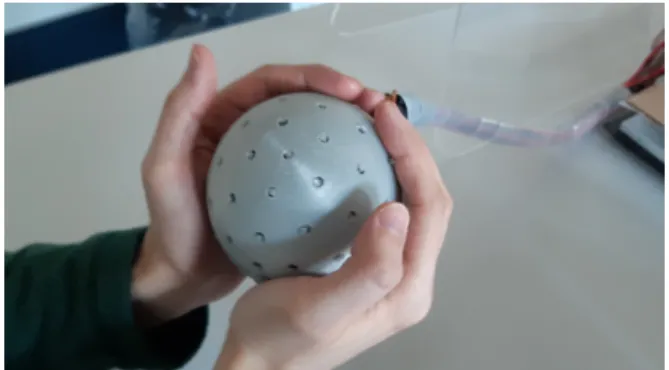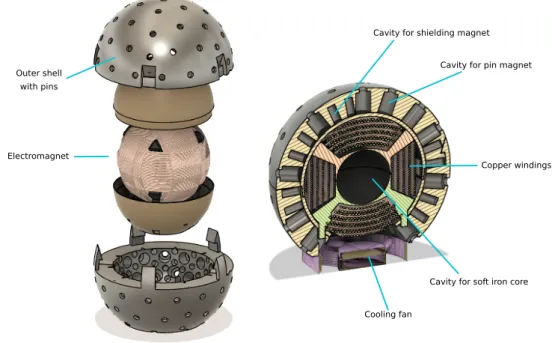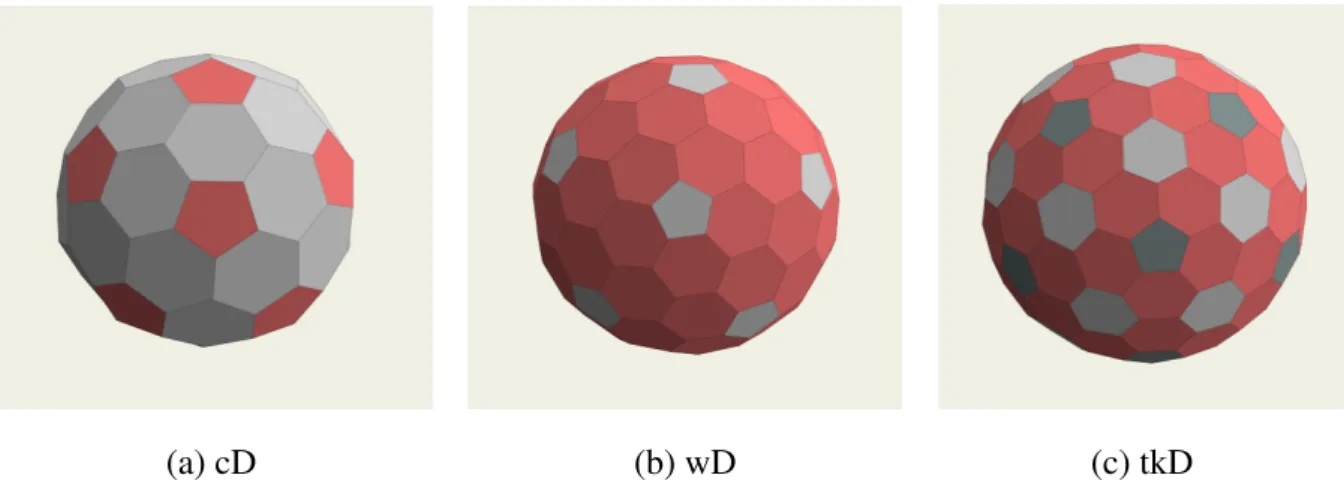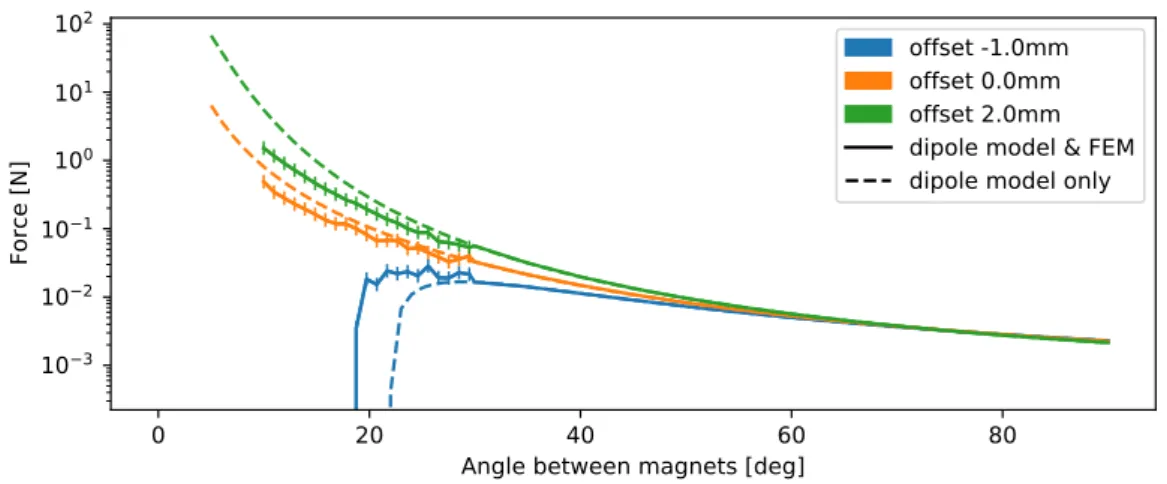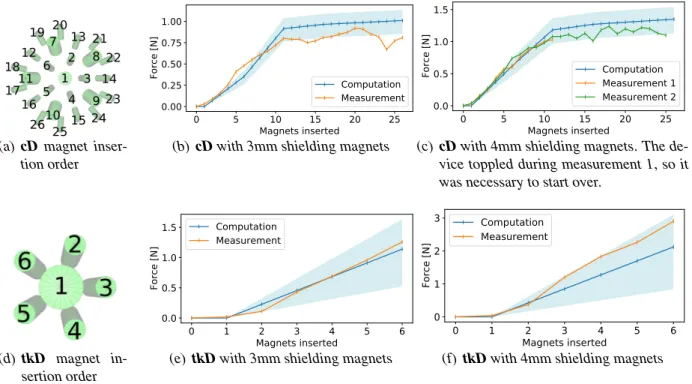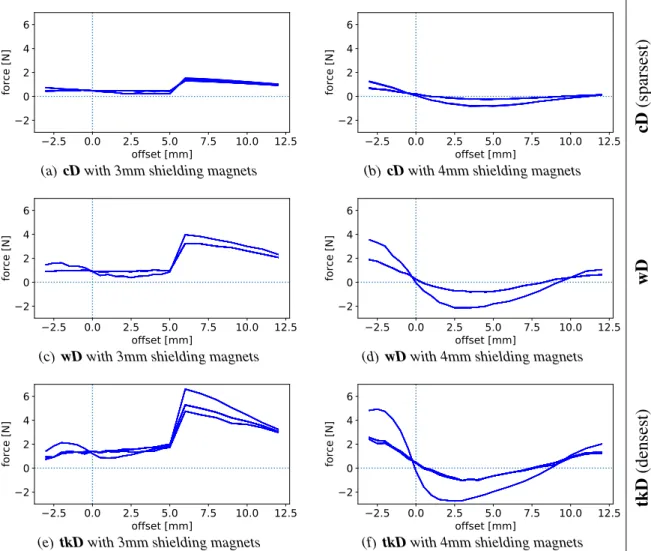Building A Hedgehog Pin Array Haptic Interface
Aline Abler
Master Thesis February 2021
Supervisors:
Dr. Juan Zarate Thomas Langerak
Velko Vechev
Prof. Dr. Otmar Hilliges
Abstract
We present Hedgehog, a self-contained spherical pin array haptic device that can function as a handheld controller and produce cutaneous haptic sensations to the user’s palms. Our design uses 86 passive magnetic pins and a single central omni-directional electromagnetic driver, allowing it to render targeted, directional haptic feedback to the user.
We describe the design choices and hardware implementation of our prototype, evaluate its characteristics, and test its haptic performance in a JND (just noticeable difference) user study.
Finally, we demonstrate its applicability in a number of sample applications, including a racing car game and a direction indicator. The applications showcase how our device can help improve video game immersion, or how it could be utilized as an aid for the visually impaired.
Our work shows how using a single central driver greatly reduces the complexity of manufac- turing and control of our device when compared to one with individually actuated pins, while still providing a rich haptic experience.
To aid in the design of passive magnetic arrays and facilitate the selection of hardware parame- ters, we further present a novel method of approximating vertical forces on individual magnets within a spherical array and predict its behavior, i.e., whether the magnets have a stable resting position and how they react to externally applied electromagnetic forces. Our method gener- alizes to other shapes of magnet arrays in which the magnets are constrained to move only vertically.
i
Contents
List of Figures v
List of Tables vii
1 Introduction 1
1.1 Contributions . . . . 2
1.2 Related Work . . . . 2
1.2.1 Pin Array Displays . . . . 3
1.2.2 Single-actuator systems . . . . 3
2 Design 5 2.1 Pin design . . . . 5
2.2 Magnetic force approximation . . . . 6
2.2.1 Method validation . . . . 11
2.3 Choice of parameters . . . . 13
2.4 Device construction . . . . 16
3 Evaluation 19 3.1 Hardware evaluation . . . . 19
3.1.1 Pin force . . . . 19
3.1.2 Pin extension . . . . 21
3.1.3 Activation spread . . . . 22
3.1.4 Comparison to Approximation Results . . . . 22
3.2 User Study . . . . 23
3.2.1 Experiment 1: Force Absolute Threshold . . . . 24
3.2.2 Experiment 2: JND of Force . . . . 24
3.2.3 Experiment 3: JND of Speed . . . . 25
3.2.4 Discussion . . . . 26
4 Application 29 4.1 Racing game . . . . 29
4.2 Orientation indicator . . . . 30
5 Limitations and Future Work 31
6 Conclusion 33
Bibliography 35
iii
Contents
List of Figures
1.1 The Hedgehog Pin Array Haptic Interface . . . . 1
2.1 Exploded view and cross-section of the prototype design . . . . 6
2.2 Diagram of haptic pin construction . . . . 7
2.3 Example of magnet arrangement in an array . . . . 7
2.4 Candidate Goldberg polyhedra . . . . 7
2.5 Illustration of function parameters . . . . 9
2.6 Example of magnetic force function . . . . 10
2.7 Setup of the force validation measurement . . . . 11
2.8 Comparison between measured and approximated (calculated) forces. . . . 12
2.9 Simulation results of force induced by our electromagnet on differently sized rod magnets . . . . 13
2.10 Comparison between characterizations of different array configurations . . . . 15
2.11 The finished prototype . . . . 17
3.1 Measurement of force exerted by a pin on the user’s skin . . . . 20
3.2 Measurement of pin extension distance . . . . 21
3.3 Comparison of force simulation to force and offset measurements . . . . 23
3.4 Example of the staircase procedure . . . . 25
3.5 JND study . . . . 27
4.1 A user enjoying the racing game demo . . . . 29
v
List of Figures
List of Tables
2.1 Polyhedron faces and theoretical pin extension . . . . 14 2.2 Parameters chosen for our prototype . . . . 16 3.1 Fitting results of pin force measurement . . . . 20
vii
List of Tables
1
Introduction
Handheld input devices are prevalent in human-computer interaction and range from computer mice to mobile phones and game or VR controllers. While primarily used as input devices, such controllers (particularly mobile phones and game controllers) are often capable of render- ing vibrotactile feedback, providing a haptic sensation to the user. Haptic feedback has many uses such as improved game immersion or notifying the user of certain events. However, the vibrotactile actuators are limited in their ability to convey more precise sensations of shape, force, or direction.
Pin array haptic interfaces, being able to render more precise haptic feedback, have been an ac- tive area of research for years. They come in the form of stationary devices [Leithinger et al. 2014], portable devices [Zarate et al. 2017], wearables [Vechev et al. 2019] and handhelds [Chen et al. 2019].
Typically, each pin can be actuated individually, which makes not only the device’s hardware complexity grow considerably when more pins are added, but also the complexity of any soft- ware controlling the device.
In this thesis, we explore the use of a magnetic pin array for haptic feedback rendering in controllers. We leverage a single omni-directional electromagnet to actuate a spherical array of
Figure 1.1: The Hedgehog Pin Array Haptic Interface.
1 Introduction
passive magnetic pins, significantly simplifying the manufacturing and operation of our device compared to traditional pin array interfaces. The spherical form factor enables new interaction paradigms, for example in combination with IMU (Inertial Measurement Unit) sensors to infer orientation.
Our work directly builds upon the Omni haptic prototype [Langerak et al. 2020], which uses an omni-directional electromagnet to induce force feedback on a passive magnetic tool held by the user. We are able to re-use hardware components of Omni, such as the electromagnet, cooling system, and the hardware control interface. We newly design a passive magnetic pin array to be mounted on top of the electromagnet, as well as new control software for the altered device.
Designing a pin array based on passive magnets requires considerations such as the magnets’
sizes, their placement, and the capabilities of the driving electromagnet. These parameters have an influence on the resulting device’s size and weight, maximum force output, and pin array density. Finding an optimal choice in that parameter space requires efficient exploration of the available options. We introduce a novel technique for estimating passive magnetic forces in pin arrays, allowing us to predict the stability and behavior of given arrays and select the optimal parameters for our prototype.
We assess the capabilities of our approach through a JND (just noticeable difference) user study exploring the operational range and limitations of our prototype device. Additionally, we present two sample applications to showcase potential use-cases for such a spherical pin array interface.
1.1 Contributions
• A novel method of evaluating the mutual interaction in non-planar arrays of passive mag- nets, allowing prediction of the array’s behavior and facilitating the selection of optimal array parameters (i.e. magnet sizes and placement)
• A handheld controller that renders haptic feedback to the user’s palm through passive magnetic pins, based on hardware components re-used from the Omni haptic proto- type [Langerak et al. 2020]
• A user study measuring the user’s force and speed sensitivity with respect to our device, through which we determine the operational range of our prototype and the minimum change in intensity that can be sensed by the user
• Sample applications demonstrating the capabilities of the prototype e.g. in video game settings, or as an aid for the visually impaired
1.2 Related Work
Nowadays, the most commonly used mechanism for haptic feedback are vibrotactile actuators.
With their small form factor and low manufacturing cost, they are easily embedded in game con-
trollers, mobile phones, and more recently in VR controllers. However, vibrotactile haptic feed-
1.2 Related Work
back is often coarse and imprecise, and while this limitation can be overcome, e.g., through the use of several vibrotactile motors and interpolating between them [Israr and Poupyrev 2011], in its most common use vibrotactile feedback is one-dimensional and fails to convey shape or directional information.
Many alternatives to vibrotactile feedback have been explored and often succeed in convey- ing higher fidelity haptic sensations—both cutaneous and kinesthetic, e.g. [Massie et al. 1994]
[Yamaoka and Kakehi 2013] [Stamper 1997] [Van der Linde et al. 2002]. These devices are usually anchored rigidly, allowing them to supply larger forces with great precision. While these prototypes are appropriate for high-end applications such as tele-operation, their size and lack of portability makes them unsuitable for handheld use.
Handheld and wearable haptic devices can provide high fidelity haptic feedback, e.g. through the use of electrostatic brakes [Hinchet et al. 2018] or tilt platforms [Benko et al. 2016]. These devices are often hard to manufacture, and additionally, controlling all the degrees of freedom they provide incurs complexity on the control software. Our approach seeks to simplify these aspects, particularly the latter, by controlling multiple movable components with a single actu- ator.
1.2.1 Pin Array Displays
Pin array displays have been around for a while and come in a large variety of execution. Most commonly, such devices are stationary and can thus make use of large activation mechanisms, e.g. linear actuators [Leithinger et al. 2014]. Other devices make use of electromagnetic ac- tuation [Zarate et al. 2017] [Yang et al. 2009] which allows for a smaller, portable form factor.
TacTiles [Vechev et al. 2019] is a wearable device that uses individually controlled pins in spe- cific locations on the palm to render haptic feedback. Haptivec [Chen et al. 2019] is a pin array display for handheld use, making it most similar to our work. Haptivec’s pins are individually actuated using solenoids.
1.2.2 Single-actuator systems
Unlike previous pin array designs, our system uses a single actuator to drive its pins. Haptic interfaces using a single actuator typically have a single point of contact for the user, such as the Foldaway prototype [Mintchev et al. 2019], where users can interact with a small 3-DOF platform mounted to a controller. Our design, being a pin array, naturally has multiple contact points on its entire surface.
The use of 3-DOF omni-directional electromagnets for haptic feedback rendering has been ex- plored in Omni [Langerak et al. 2020], where said electromagnet is used to render force feed- back to a passive magnetic pen held by the user. Omni serves as the primary inspiration for our work, and several hardware components of the Omni prototype were re-used, most notably the electromagnet itself.
3
1 Introduction
2
Design
Our haptic interface leverages a single central omni-directional electromagnet to actuate its pins, which are attached to passive magnets (Figure 2.1). This imposes the restriction that all these passive magnets have to be oriented in the same direction (inward or outward), such that the single electromagnetic driver can actuate them all equally. To avoid magnetic cross-talk due to the passive magnets repelling each other, an arrangement has to be found in which all passive magnets have a stable resting position that is not affected by neighboring magnets moving around.
2.1 Pin design
The haptic pins are small acrylic cylinders attached to passive magnets (pin magnets), which are embedded in a plastic casing that only allows the pin magnets to move vertically (see Fig- ure 2.2).
In order to avoid magnetic cross-talk between pin magnets and to keep the entire array in a stable configuration, smaller shielding magnets of opposite polarity are inserted in between pin magnets (also depicted in Figure 2.2). These will hold the pin magnets in a stable resting position when the electromagnet is deactivated. We choose a hexagonal arrangement for pin and shielding magnets.
Since plain hexagonal arrangements are planar and cannot be directly wrapped around a sphere, we pick the magnet locations based on an icosahedral Goldberg polyhedron (see Figure 2.4).
The icosahedral Goldberg polyhedra form an infinite class of convex polyhedra consisting of
hexagons and pentagons, which allows for a hexagonal magnet arrangement with relatively few
irregularities. Figure 2.3 shows an example of such a Goldberg arrangement of pin and shielding
magnets. Throughout this thesis, specific Goldberg polyhedron based arrangements are referred
to by the corresponding Conway polyhedron notation [Conway et al. 2016].
2 Design
Figure 2.1: Exploded view and cross-section of the prototype design. The larger cavities in the outer- most shell hold the pin magnets, allowing for a few millimeters of vertical movement and containing a smaller hole for the pins to extend through. The smaller cavities hold the shield- ing magnets, which remain stationary. Magnets are inserted from the inside and held in place with a thin hemispherical shell, which in turn encases the electromagnet.
Choosing the sizes (and, as a result, strengths) of pin and shielding magnets presents an opti- mization problem. The following aspects need consideration:
• The electromagnet can induce larger forces in stronger magnets, but at the same time, small magnets are desirable as they allow for a more compact design and a denser pin array.
• The shielding magnets have to be strong enough to retain the pin magnets in their resting positions, but that retaining force has to be small enough to be overcome by the electro- magnet, whose maximum force output is constrained by overheating concerns. In other words, the relative sizes of pin and shielding magnets have to be chosen such that the latter are only just able to retain the former, but not more.
2.2 Magnetic force approximation
In order to determine whether a given magnet arrangement has a stable resting position, it is necessary to calculate the vertical force induced on a specific pin magnet by all other magnets.
Only the vertical force is of interest, as the magnet’s lateral movement is constrained and ro-
tation is irrelevant thanks to our use of cylindrical magnets. To calculate this vertical force,
we developed a method of approximating passive magnetic forces in a pin array consisting of
differently sized and oriented magnets.
2.2 Magnetic force approximation
Figure 2.2: Diagram of haptic pin construction.
Figure 2.3: Example of magnet arrangement in an array.
Shielding magnets are rendered in red, pin magnets in green.
(a) cD (b) wD (c) tkD
Figure 2.4: Candidate Goldberg polyhedra. To achieve a spherical hexagonal arrangement, a pin magnet is placed at the center of each face and a shielding magnet is placed at each vertex. The Conway polyhedron notation [Conway et al. 2016] of each polyhedron is given.
The colors indicate groups of faces which are equal w.r.t. symmetry.
While there exist Goldberg polyhedra with arbitrarily many faces, at some point the magnet’s size makes it impossible to place that many on a fixed-size sphere. In our case, (c) is the densest possible arrangement.
7
2 Design
Our method relies on three observations:
• Our setting includes only permanent magnets as well as the electromagnet’s core, which magnetizes linearly. No non-linear magnetic components are included, which allows us to sum up partial magnetic forces to obtain an overall result. Using this technique, it thus suffices to calculate the vertical magnetic force only between each pair of permanent magnets.
• For any given magnet in an arrangement, most of the other magnets are sufficiently far away such that the magnetic force between them can be accurately estimated by modeling both magnets as magnetic dipoles [Yung et al. 1970]. The dipole model provides a closed- form solution and can be easily calculated.
• For the few remaining magnet pairs that are too close together for use of the dipole model, it is feasible to utilize FEA (Finite Element Analysis) simulations, which can accurately solve the Maxwell equations for meshed geometries. The results, while sufficiently accu- rate, are computationally costly, so we rely on them only for these few remaining magnets.
Our FEA results are obtained using Comsol Multiphysics with its magnetic modules, which are utilizing Maxwell differential equations in a meshed volume. In our case, this volume contains a pair of passive magnets and the surrounding air.
This method allows us to calculate the vertical force induced on a specific magnet by all other magnets in the arrangement, using only a small number of computationally expensive FEA simulations.
We can further improve upon the method by re-using FEA results. To this end, we leverage the fact that our magnet positions are constrained to the surface of a sphere. The relative po- sition between any pair of magnets is thus given by the angle between their position vectors (Figure 2.5).
We consider the function P airF orce
ma,mb(α) that calculates the vertical force acting between two passive magnets m
aand m
bgiven their relative angle α. For large α, we utilize the dipole model to directly calculate an approximate result. To obtain results for small α, we first use a selection of angles α for which we simulate the result of P airF orce
ma,mb(α) using FEA; with these results we can create a piece-wise linear interpolation of the function P airF orce
ma,mb(α), from which we can sample an approximate result for any α. A plot of the thus approximated function P airF orce
ma,mb(α) is given in Figure 2.6.
P airF orce
ma,mb(α) =
( F EA
ma,mb(α) α < 30
◦DipoleM odel
ma,mb(α) otherwise. (2.1) Having obtained an approximation of P airF orce
ma,mb(α), we are now able to re-use it for vertical force calculations on different magnet arrangements, provided they are all constrained to the same sphere.
To accommodate for the use of differently sized magnets, the function P airF orce
ma,mb(α) is
parameterized by the sizes of the two magnets in question. The two magnet sizes m
aand m
bare given by the magnets’ heights and diameters. For each combination of magnet sizes in an
2.2 Magnetic force approximation
Figure 2.5: Illustration of parameters for function P airF orce
ma,mb(α, o). The function’s result is the vertical force induced on m
aby m
b. Both magnets have the same polarity (north pointing outwards).
arrangement, F
ma,mb(α) is approximated anew using the method detailed above.
Although the function P airF orce
ma,mb(α) has to be calculated anew when changing magnet sizes, the same is not necessary when the polarity of either magnet changes. A change in polarity simply represents a sign change of the function result, which can be taken into account when summing up individual results.
We can now calculate an approximation of the vertical force F
minduced on magnet m by all other magnets in arrangement M:
F
m= X
mi∈M\m
P airF orce
m,mi(angle(m, m
i)) ∗ polarity(m, m
i) (2.2)
with
polarity(m
a, m
b) =
( 1 if m
aand m
bhave same polarity
−1 otherwise. (2.3)
Using our method, we can approximate the vertical force induced on any given pin magnet by all other magnets in an array.
However, in this situation, all magnets remain stationary. Since our pin magnets are able to move outwards, it is necessary to understand how the induced vertical force changes as a magnet moves vertically. In the extreme case, when considering a flat array, the vertical forces would be zero in the resting position, but if a magnet is moved vertically even slightly, these forces could increase dramatically.
To understand the influence of vertical movement on the force, we extend our function by an additional parameter o representing the vertical offset of the first magnet. Figure 2.5 gives an illustration of the function’s parameters. P airF orce
ma,mb(α, o) is approximated using the same method as before, though the number of required FEA simulations increases with the parameter
9
2 Design
0 20 40 60 80
Angle between magnets [deg]
10
310
210
110
010
110
2Force [N]
offset -1.0mm offset 0.0mm offset 2.0mm dipole model & FEM dipole model only
Figure 2.6: Example of magnetic force function approximation P airF orce
m4mm,m2mm(α, o) display- ing the vertical force which a magnet with 2mm radius exerts on a magnet with 4mm radius at different angles apart, at various offsets o. Both magnets have a height of 10mm.
In our approximation, values below 30 degrees are found using FEA simulations, values above 30 degrees are found using the dipole model for calculating forces between magnets.
For comparison, the dipole model results for all values are given in this graph in addition to the FEA results.
Vertical markers indicate the points at which a FEA simulation was performed to obtain the result. Values in between are linearly interpolated.
space. In order to evaluate the behavior of a given pin magnet m
p, we consider the function F
mp(o) which calculates the vertical force induced on magnet m
pby each other magnet in a given arrangement M for each vertical offset o.
F
mp(o) = X
mi∈M\mp
